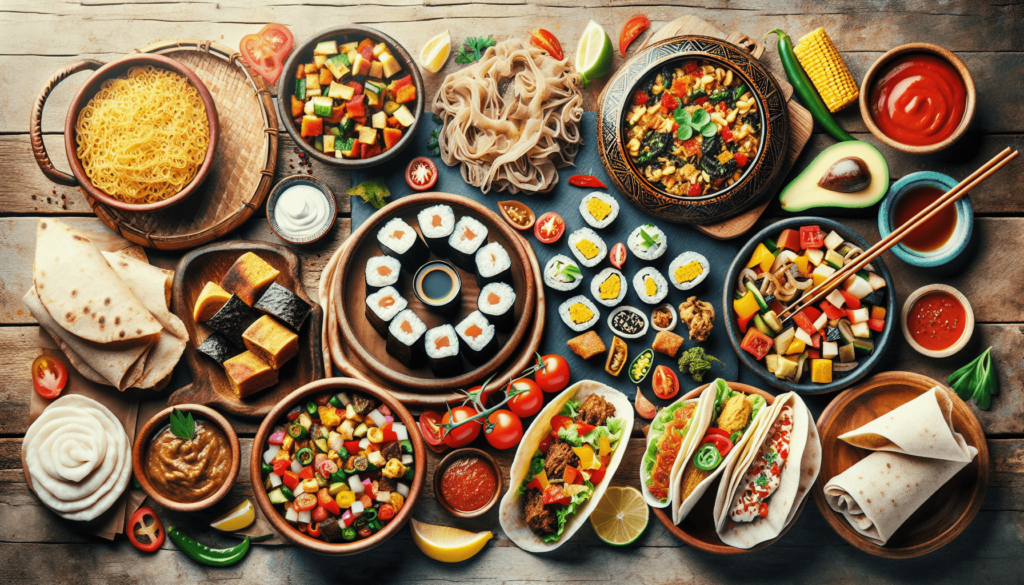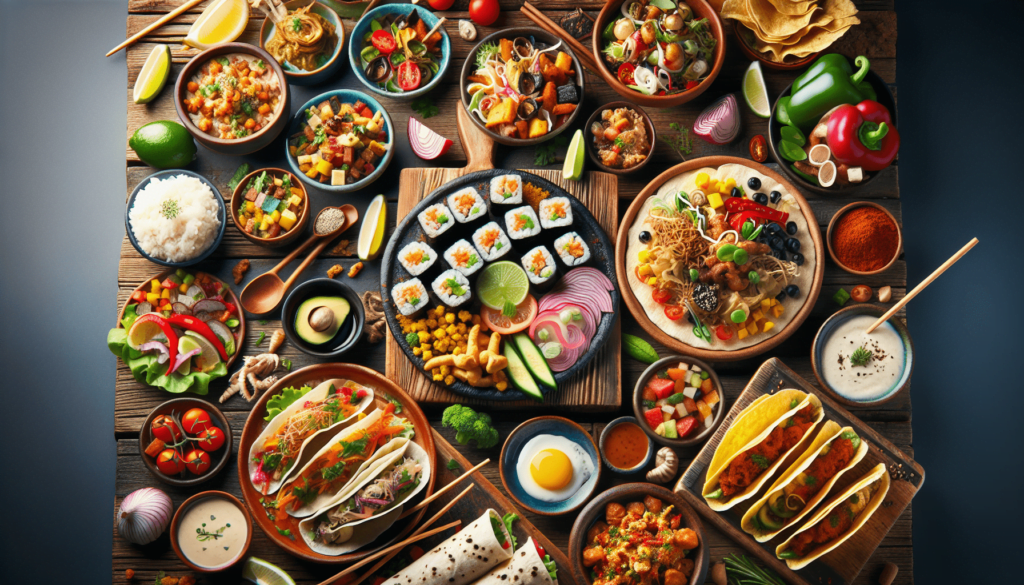Plunge into the vibrant world of global cuisine with “A Taste of Adventure: Exploring Flavors Around the World.” This engaging journey takes you through the rich history of culinary traditions, offering insights into how flavors have evolved across continents. You’ll discover current trends that shape today’s food landscape, from street food revolutions to the rise of fusion restaurants.Along the way, you’ll gain a deep understanding of key concepts like umami and terroir, and explore detailed case studies that highlight the diverse tapestry of global tastes.
By examining different perspectives and assessing their impacts, this article not only deepens your appreciation for international flavors but also contemplates future culinary trends and their broader implications on society. Embark on this adventure, and let your taste buds experience the world like never before. Have you ever wondered what makes the cuisine of one country different from another? Or perhaps you crave the adventure that comes with tasting new and exotic flavors? If so, you’re in the right place!

Table of Contents
Overview
A Taste of Adventure: Exploring Flavors Around the World isn’t just about food; it’s a journey through culture, history, and community. In an interconnected world, where even the most exotic ingredients can be delivered to your doorstep, understanding and appreciating global flavors has become more relevant than ever. This craving for adventurous eating allows us to learn about diverse traditions, opening windows into countless cultures, each with their unique flavors and culinary traditions.
Historical Context
For centuries, people have been exploring new flavors as they trade, migrate, and conquer new lands. Think of the Silk Road—the ancient network of trade routes that connected the East and West. Spices like cinnamon, cardamom, and saffron traveled these routes, influencing the flavors of local cuisines along the way. The Age of Exploration further broadened the global spice palette, as explorers brought back new tastes from the Americas, Asia, and Africa. The history of global flavors is a testament to human curiosity and our endless pursuit of sensory delight.
Current Trends
Nowadays, global flavors are more accessible than ever. fusion cuisine blends elements from different culinary traditions to create innovative dishes. For example, Korean tacos and sushi burritos are the perfect embodiment of these global culinary crossovers. Online platforms and food delivery services have made it easier for us to explore these flavors from the comfort of our homes. Additionally, there is a growing interest in sustainable and locally sourced ingredients, which adds another layer of complexity and richness to our culinary experiences.
Key Concepts and Definitions
To dive deeper into the world of flavors, let’s clarify some key concepts:
- Umami: Known as the fifth taste, umami is a savory flavor often found in aged cheese, soy sauce, and tomatoes.
- Fusion Cuisine: A culinary trend that combines elements of different culinary traditions to create unique dishes.
- Fermentation: A natural process that enhances flavors and preserves food; think of kimchi, sauerkraut, and yogurt.
- Molecular Gastronomy: A sub-discipline of food science that seeks to investigate the physical and chemical transformations of ingredients that occur in cooking.

Detailed Exploration
A Feast for the Senses: Italian Cuisine
Italian food is synonymous with comfort and simplicity. Imagine the distinct aroma of freshly baked pizza, the rich taste of handmade pasta, or the creamy texture of gelato. The emphasis on high-quality ingredients, such as olive oil, garlic, and basil, underscores the country’s devotion to fresh and vibrant flavors.
The Spicy Depths of Indian Cuisine
India is a land of spices. From the earthy heat of cumin and coriander to the fiery kick of chili peppers, Indian cuisine is all about balancing diverse flavors. Consider a bowl of butter chicken or a plate of biryani; each bite is a harmonious blend of spices, herbs, and ingredients that have been lovingly marinated and cooked to perfection.
Example 1: The Global Influence of Mexican Cuisine
Let’s take a closer look at Mexican cuisine, a prime example of how local ingredients and centuries-old traditions can create rich and varied flavors. The use of corn, beans, and chili peppers forms the foundation of many Mexican dishes. Enchiladas, tacos, and tamales are just a few examples of how these ingredients come together to create mouth-watering meals. In recent years, Mexican cuisine has seen a surge in popularity around the world, with chefs incorporating these flavors into everything from haute cuisine to street food.
The Role of Street Food in Flavor Exploration
Street food serves as an excellent gateway to explore global flavors. It’s accessible, inexpensive, and often provides a more authentic taste of local culinary traditions. Whether it’s the grilled meats of Moroccan kebabs, the aromatic spices of Thai curries, or the rich flavors of Turkish döner, street food offers a quick and satisfying way to brave new flavors.
Example 2: The Complexity of Japanese Umami
Japanese cuisine is renowned for its meticulous preparation and presentation. Imagine savoring a bowl of ramen, where every ingredient—from the broth and noodles to the toppings—has been carefully selected and prepared to create a harmony of flavors. The concept of umami is central to Japanese food, often derived from ingredients like miso, soy sauce, and seaweed. Sushi, tempura, and sashimi are other staples that showcase the complexity and elegance of Japanese culinary tradition.
Fusion Cuisine: A New Frontier
Fusion cuisine challenges traditional boundaries by blending flavors and techniques from different culinary traditions. A sushi burrito, for example, combines the delicate flavors of Japanese sushi with the hearty, hand-held nature of a burrito. Similarly, Korean tacos might take the bold, spicy flavors of Korean barbecue and wrap them in a familiar Mexican tortilla. These inventive dishes exemplify how fusion cuisine can elevate our culinary experiences to new and exciting heights.
Comparison of Different Perspectives
While some may argue that global flavors need to stay “authentic” to preserve cultural heritage, others see fusion cuisine and the blending of flavors as a natural evolution and reflection of our increasingly interconnected world. Authenticity offers a sense of tradition and cultural history, providing a culinary time capsule that honors the past. On the other hand, fusion cuisine promotes innovation and inclusivity, ensuring that flavors continue to evolve and adapt to new contexts.
The Authenticity Debate
Authentic cuisine can foster a deep understanding of a culture’s values, traditions, and history. It offers a form of cultural storytelling, with each bite transporting you to a different place and time. However, strict adherence to authenticity can sometimes stifle creativity and innovation, potentially limiting our culinary exploration.
The Case for Fusion
Fusion cuisine encourages experimentation and creativity. By blending different culinary traditions, it allows chefs and home cooks alike to push the boundaries of flavor, creating dishes that are not only delicious but also innovative. Fusion cooking can also make exotic flavors more accessible to a broader audience, introducing people to ingredients and techniques they might not otherwise encounter.
Impact Assessment
Both perspectives have their merits, and their impacts are equally significant. Authentic cuisine preserves cultural heritage and ensures that traditional flavors are passed down through generations. However, the embrace of fusion cuisine can lead to a more universally inclusive culinary landscape, fostering greater appreciation and understanding of diverse flavors.
Future Directions and Implications
As we look to the future, several trends and developments will likely shape our culinary experiences:
- Sustainability: As awareness of environmental issues grows, there will be a stronger focus on sustainable and locally sourced ingredients. This shift could redefine traditional dishes, incorporating more eco-friendly practices.
- Technology: Advances in food technology, such as lab-grown meat and AI-generated recipes, will open new avenues for flavor exploration. These innovations can lead to more ethical and customized food experiences.
- Global Mobility: As travel becomes more accessible, people will have more opportunities to explore and experience global flavors firsthand. This exposure will further fuel the demand for authentic and fusion cuisines alike.
Broader Implications
The exploration of global flavors is more than just a culinary adventure; it’s a way to connect with different cultures and communities. It fosters empathy, understanding, and appreciation, helping to bridge cultural divides. It also encourages culinary innovation, ensuring that our food landscape remains dynamic and exciting.
Conclusion
Exploring global flavors is akin to embarking on a culinary journey around the world. It’s about appreciating the richness and diversity of different culinary traditions, while also embracing the creativity and innovation that comes with blending these flavors. From the historical significance of ancient spice routes to the modern-day popularity of fusion cuisine, our quest for new and exciting flavors is a testament to our innate curiosity and love for good food.
So, the next time you’re wondering what to make for dinner, why not take a culinary trip around the world, one dish at a time? And as you savor each bite, think about the history, culture, and innovation that have come together to create the flavors you enjoy. Remember, the world of flavors is vast and ever-changing, promising a lifetime of delicious discoveries.
Feel free to share your favorite global flavors or fusion creations in the comments below. Your culinary adventures could inspire others to embark on their own flavorful journeys. Happy eating and exploring!
Credible Sources
- Historical Context
- “The Silk Road: A History” by Peter Francopan
- “Spices, Scents, and Silk: Catalysts of World Trade” by James F. Hancock
- Current Trends
- “The Next Global Stage: The Challenges and Opportunities in Our Borderless World” by Kenichi Ohmae
- “Modernist Cuisine: The Art and Science of Cooking” by Nathan Myhrvold
- Key Concepts and Definitions
- “On Food and Cooking: The Science and Lore of the Kitchen” by Harold McGee
- “Flavor: The Science of Our Most Neglected Sense” by Bob Holmes
- Detailed Exploration
- “Italy: The Country and Its Cuisine” by Michael White
- “Indian Food: A Historical Companion” by K. T. Achaya
- Example Case Studies
- “Mexico: The Cookbook” by Margarita Carrillo Arronte
- “Japanese Cooking: A Simple Art” by Shizuo Tsuji
- Fusion Cuisine
- “Fusion Food in the Vegan Kitchen: 125 Comfort Food Classics, Reinvented with an Ethnic Twist!” by Joni Marie Newman
By diving into these rich resources, you can deepen your understanding of global flavors and enhance your culinary repertoire. Bon appétit!
